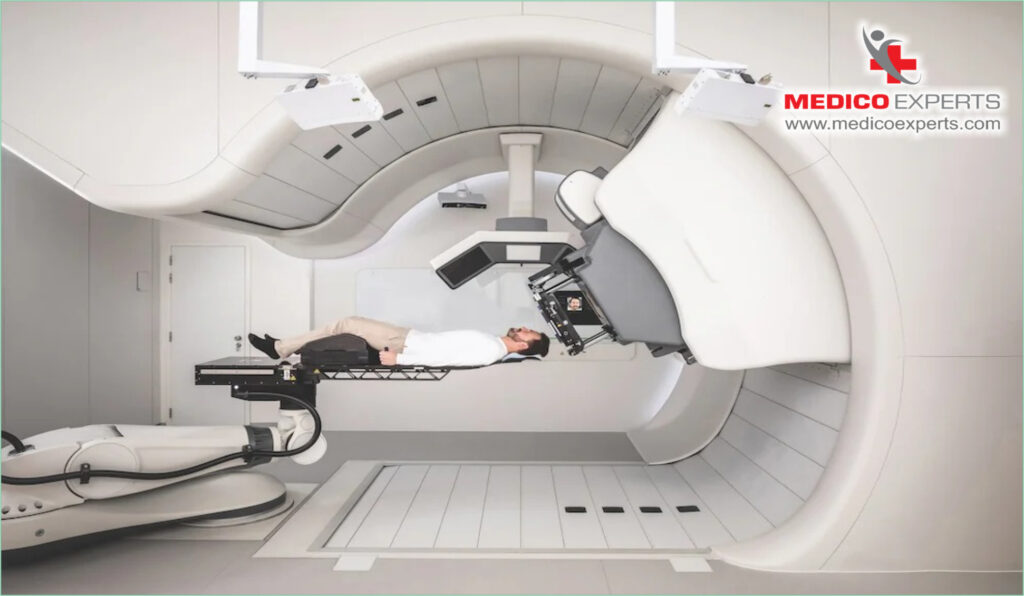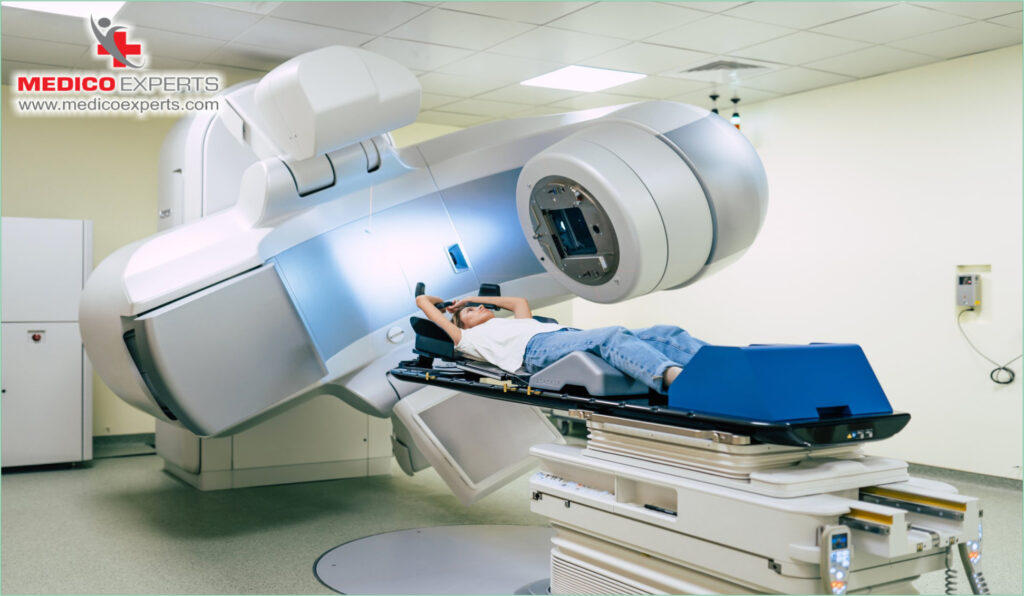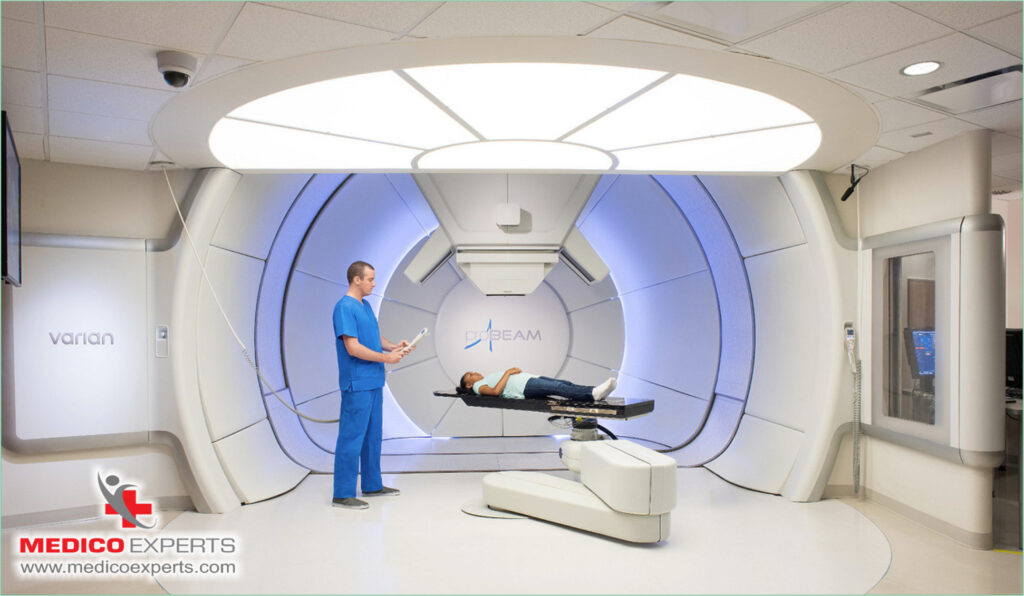We understand that cancer diagnosis takes a toll on your mental and physical health. On top of that when you need to make decisions like: “proton therapy vs traditional radiation therapy, which one is better” you might feel overwhelmed.
You cannot decide based on your preferences. You need to consider the effectiveness, side effects, and long-term impact of radiation therapy and proton therapy. You need to be aware of what each method brings to the table before opting for one.
That’s why, we will explain the key differences between proton therapy and traditional radiation therapy to help you feel more confident while making your decision.
Key Takeaways
- When compared to standard radiation, proton treatment provides more accuracy. It targets cancer cells while causing little harm to adjacent healthy tissues.
- Because of the tailored approach with Proton treatment, you may suffer fewer side effects and recover more quickly.
- Traditional radiation is generally more affordable and widely available, while proton therapy is limited to specialized centers and may be more expensive.
- Both methods are effective, but ongoing research is exploring how they can be improved for cancer treatment. But the right choice for you will depend on the type, location, and stage of your cancer.
- At MedicoExperts, we’re here to provide you with comprehensive information and help you access cutting-edge treatments like proton therapy.
What Is Proton Therapy?

Proton therapy is also known as proton beam therapy. It’s an advanced radiation therapy that could be an option for you or your loved one.
But what makes proton therapy special is its precision. The proton radiation process starts by taking precise measurements of your tumor’s shape, location, and depth. Proton beams are designed to deliver low energy as they enter your body and emit minimal radiation as they exit. They work by damaging the DNA in the cancer cells, preventing them from growing or spreading. This targeted approach reduces radiation exposure to your surrounding healthy tissues, lowering your risk of side effects. By focusing on the genetic makeup of your cancer cells, proton therapy destroys them and prevents them from multiplying further.
This precise approach is especially important for cancers near critical areas like your brain, heart, or spinal cord.
It’s a great option for you or pediatric patients if your cancer is localized, near vital organs, or if you have already had radiation in the same area. This is important for children and teens as their bodies are still growing, and proper development requires adequate nutrition, exercise, and care. It can make a big difference as they get older. It minimizes exposure to healthy tissues, reducing the risk of long-term side effects from radiation.
This treatment has been effective for many types of cancer, including brain tumors, head and neck cancers, bone cancer, and cancers of the lungs, liver, and gastrointestinal tract.
What Is Traditional Radiation Therapy?

Traditional Radiation Therapy is also known as photon therapy. It is among the most frequent cancer therapies. Nearly 50% of all cancer patients require radiation therapy as part of their treatment plan.
This method uses high-energy X-rays or gamma rays (photons) to target and destroy your cancer cells. These rays are powerful enough to pass through your body and reach the tumor. They damage the cancer cells to stop them from growing or spreading.
However, because photons travel through your body, they release energy at the tumor site and along their path. This means your healthy tissues and nearby organs could also be affected resulting in health problems over time. These side effects may differ based on the dosage and location of your therapy.
So doctors may use lower radiation doses to minimize the impact on your healthy tissue. However, this could make your cancer treatment less effective.
If you are considering radiation therapy, it’s very essential to talk to a radiation oncologist. They can walk you through your options, be the traditional photon therapy or alternatives like proton therapy.
Comparison Chart: Proton Therapy vs Traditional Radiation Therapy
| Factor | Proton Therapy | Traditional Radiation Therapy |
| Side Effects | Fewer side effects for you due to the precise targeting of tumors, sparing your surrounding healthy tissues. | You may experience more side effects as healthy tissues before and after the tumor receive radiation. |
| Recovery Period | Faster recovery. You can often return to your daily activities shortly after treatment. | Your recovery might take several weeks to months. This depends on your dose and treated area. |
| Precision (Dose Distribution) | Highly precise treatment ensures no exit dose of radiation, reducing damage to your surrounding tissues. | Less precise treatment may result in X-rays passing through your body, exposing your healthy tissues to radiation before and after the tumor. |
| Number of Sessions Needed | You typically need fewer sessions because of increased accuracy, making therapy more successful in fewer visits. | Multiple sessions over several days or weeks may be required to ensure the cumulative dosage is effective while sparing your normal tissues. |
| Return to Daily Life | Safe and with minimal difficulties, allowing you to return to your routine activities sooner. | You may face more downtime from prolonged side effects such as fatigue or skin irritation. |
| Treatment Planning | Fewer treatment angles and more flexibility in dose that minimizes your exposure to normal tissue. | Requires multiple beams and angles to achieve coverage, often exposing your normal tissues to lower doses of radiation. |
What are the Advantages of Proton Therapy?
Proton treatment has numerous significant benefits over traditional radiation therapy. Here’s why this innovative treatment might be the right choice for you or your loved one:
High Precision With The Bragg Peak Effect
Proton therapy uses the Bragg Peak effect. The Bragg Peak targets your tumor with maximum energy while protecting the healthy tissue around it.
The energy level lowers significantly after the tumor is destroyed. Thus leaving tissues beyond it mostly unharmed. This precision allows your treatment team to target the tumor with tremendous accuracy.
Minimal Impact On Your Healthy Tissues
With proton therapy, the exposure to healthy tissues is much lower than with conventional radiation therapy.
This results in fewer side effects for you and greater protection for critical skills like memory and speech, particularly if your tumor is located near sensitive regions such as the brain or nerves.
Reduced Long-Term Side Effects
Proton therapy can help you avoid many long-term side effects that come with standard radiation.
Addressing the challenges early can help you prevent potential issues such as growth disturbances, fertility challenges, or hormonal imbalances. It also lowers your chance of developing secondary cancers caused by radiation, giving you peace of mind for the future.
Ideal For Tumors In Complex Locations
If your tumor is irregularly shaped or located near vital organs, proton therapy’s precision makes it an excellent choice.
Whether your tumor is in the brain, spine, or another critical area, proton beams can be directed with pinpoint accuracy to treat it effectively while protecting the surrounding tissues.
Limitation Of Radiation-Induced Secondary Tumor
Radiation-induced secondary cancers are a rare but important long-term effect of radiation therapy you should be aware of as a cancer survivor.
Your risk depends on factors like your age, the radiation dose, the amount of normal tissue exposed, your family history, and your biological risk. This risk is cumulative and lasts a lifetime, which is why if you are not treated early, you may have the greatest risk of developing a radiation-induced malignancy.
Enhancing Quality Of Life During And After Treatment
Proton therapy offers you highly precise treatment, targeting tumors while sparing your healthy tissue. This means fewer side effects and a better quality of life for you during and after treatment.
It enhances cancer control and reduces complications, giving you the chance for a healthier, longer life. With ongoing advancements, proton therapy is continually improving care to help you achieve the best possible outcome.
Proton therapy is designed with your safety and well-being in mind. It’s a more targeted, thoughtful way to treat cancer, helping you or your loved one achieve better outcomes while minimizing the physical and emotional burden of treatment.
Understanding the Differences between Proton Therapy vs Traditional Radiation
Radiation therapy is a critical part of cancer treatment. Therefore understanding your options can make all the difference. The common approaches are proton therapy, traditional radiation methods (photon therapy), and IMRT (Intensity Modulated Radiation Therapy).
Understanding how they differ in terms of delivery techniques, accuracy, cost, and patient experience can allow you to make an informed selection for yourself or a loved one.
Proton Therapy Vs Photon Therapy
Photon therapy treats cancer using high-energy X-ray rays. These X-ray beams pass through your body and target the tumor. In the process of exiting, some of your nearby healthy tissues are exposed to radiation. Although modern technologies help to lower this exposure, some effects on nearby organs are unstoppable.
But on the other hand, Proton therapy works differently. With protons, the radiation can be precisely stopped at a specific depth in your body. This means there’s no exit dose, significantly reducing exposure to healthy tissues and organs near your tumor. This precision can lower the risk of long-term side effects, like radiation-induced secondary cancers.
Because protons allow for such precise targeting, proton therapy can be effective for treating cancers near your vital organs. If minimizing side effects is your priority, this unique approach could be appropriate for you.
Proton Therapy Vs IMRT
The preference between proton therapy and IMRT will depend on various factors. This could include the type of cancer, its location, and your budget. IMRT is highly effective and uses advanced imaging to shape the radiation beams to fit your tumor. By varying angles and intensities, IMRT helps minimize your exposure to healthy tissues as much as possible.
Proton therapy takes precision even further. The proton beam is precisely shaped to match your tumor. This guarantees that your deeper tissues receive the appropriate dosage while surrounding organs are protected from pointless radiation. If your tumor is near critical places like your brain, heart, or spinal cord, this is extremely significant.
However, cost is a major consideration. Proton treatment is substantially more costly than IMRT, frequently costing twice as much. IMRT is widely available and successful in most instances. Proton therapy’s increased precision may be worthwhile if keeping healthy tissue is required for better long-term results.
As for the treatment experience, both options are painless and non-invasive. Proton therapy sessions might take slightly longer due to the precise adjustments required.
Proton Therapy Survival Rates and Outcomes

Proton treatment provides promising survival rates and new opportunities for you and your loved ones. You understand how important effective therapies with minimal side effects are.
A study from the University of Pennsylvania examined nearly 1,500 adults with advanced cancers treated with chemotherapy and radiation. It found that within 90 days of starting treatment, only 12% of those who had proton therapy experienced severe side effects, compared to 28% with traditional radiation, making proton therapy a more manageable option.
Another research by UF Health Proton Therapy Institute found that five years after treatment, 99% of men with low- and intermediate-risk prostate cancer and 76% of those with high-risk prostate cancer were cancer-free. A follow-up study of over 1,300 men confirmed these impressive survival rates.
Proton treatment does more than only reduce side effects. It helps you keep your everyday routine. You are considerably less likely to see a deterioration in your capacity to do daily duties, allowing you to maintain some independence and have a higher quality of life while in treatment.
A recent study on lung cancer treatment found that no patients experienced severe Grade 4 or 5 side effects, and fewer than 10% had Grade 3 side effects, showing improved safety. Patients undergoing proton therapy achieved a 3-year survival rate of 63.7%, a significant improvement compared to the historical 23.8%–38% survival rates with traditional treatments.
And while proton therapy reduces side effects, it doesn’t compromise on fighting cancer effectively. After three years, proton therapy survival rates were nearly the same: 56% for proton therapy patients and 58% for those with traditional radiation.
Nearly half of the patients in both groups remained cancer-free. Proton therapy helps improve how you feel during treatment and delivers outcomes you can count on. It’s an advanced, supportive option that prioritizes both effectiveness and your well-being.
What is the Cost and Accessibility of Proton Therapy?

Proton therapy is one of the advanced cancer treatments that uses positively charged particles called protons to target tumor cells specifically.
India stands out as a remarkable option for proton therapy. India offers top-notch medical services, skilled professionals, and affordable treatment options. While proton therapy may seem costly, effective planning can help you overcome the expenses. Proton therapy in India usually costs you between INR 45,000 and INR 65,000 (around $540 to $780). The cost covers consultation fees, treatment sessions, and follow-up care.
Many insurance companies, like MedicoExperts, now acknowledge the advantages of proton treatment and may pay some or all of the costs for qualified patients.
Be sure to check with your insurance company to see what’s included in your plan.
Proton therapy centers are becoming more accessible, with new facilities opening worldwide. This means you can find treatment closer to home or explore more affordable options abroad, like India. If you are considering proton therapy, reach out to a trusted healthcare provider or MedicoExperts. The team will help you understand the costs, insurance coverage, and resources available to support your treatment journey.
Latest Developments in Proton Therapy

Proton treatment is continually changing. Some of the most recent improvements rely on innovative methods like pencil beam scanning and adaptive proton therapy. They are intended to make your treatment more accurate and successful.
With pencil beam scanning, the proton beam paints your tumor layer by layer, targeting cancer cells while preserving the surrounding healthy tissue. Adaptive proton therapy takes this accuracy a step further by making real-time modifications throughout your treatment depending on changes in your body, guaranteeing exact targeting while reducing adverse effects. These advances aim to make your therapy as successful and comfortable as possible.
Ongoing research is being aimed at expanding proton treatment to include head and neck, lung, prostate, esophageal, and even pediatric malignancies. Researchers are looking at how combining proton therapy with medicines like chemotherapy and immunotherapy might improve your outcomes.
Each improvement is aimed at providing safer, more effective treatment. The future of proton therapy seems promising, bringing us closer to tailored cancer therapies that emphasize your health and quality of life.
Conclusion

Proton therapy is a precise and successful way to treat your cancer. This therapy targets your tumor by minimizing harm to healthy cells. This means a higher chance of facing fewer side effects compared to conventional radiation. This can greatly enhance your overall well-being throughout and following the treatment.
Research suggests that proton therapy may improve your survival rate and reduce complications in the long run. However, the cost might be a concern for you and your family. The technology is advancing, making it more accessible over time, and ongoing studies are confirming its long-term safety and effectiveness.
If you are considering proton therapy, it’s important to talk with a specialist. MedicoExperts connects you with experienced professionals who can guide you in determining if proton therapy is the right choice for your situation. With the right information and support, you can make an informed decision that could significantly impact your treatment and recovery.
Frequently Asked Questions (FAQs):
Q1. What makes proton therapy more precise than traditional radiation?
A. Proton treatment employs proton beams that may be precisely focused to give radiation directly to the tumor. Unlike typical radiation, proton beams end at a particular depth in your tissue, limiting exposure to healthy tissues and organs. This accuracy decreases side-effects and allows for larger doses of radiation to be given directly to your tumor as needed.
Q2. Am I a candidate for proton therapy?
A. You may be a candidate for proton therapy if your tumor is close to essential organs, if you have recurring cancer that needs to be treated again, or if your child has cancer. Moreover, to understand if proton therapy is correct for you, you will need a thorough consultation from an expert. At MedicoExperts, we’re here to help you access advanced treatments like proton therapy, ensuring you receive the care you need for the best possible outcome.
Q3. Does my insurance cover proton therapy, and how can I access it?
A. Insurance coverage for proton therapy depends on your provider, policy, and treatment location. Some policies cover it if it’s considered medically necessary. Talk to your insurance company and healthcare provider to understand your options. Many hospitals and treatment centers also offer financial counselling to help you review costs and explore payment plans or assistance programs.
Q4. How does proton therapy compare to photon therapy or IMRT?
A. Proton therapy is often more precise than photon therapy or Intensity-Modulated Radiation Therapy (IMRT). While photon therapy and IMRT use X-rays that pass through your body and may affect surrounding healthy tissues, proton therapy minimizes this by delivering energy only to your tumor. This can mean fewer side effects for you, particularly if organ preservation is critical.
References
https://www.cancer.gov/news-events/cancer-currents-blog/2020/proton-therapy-safety-versus-traditional-radiation#:~:text=Traditional%20radiation%20delivers%20x%2Drays,to%20damage%20nearby%20healthy%20tissues
https://www.cancer.gov/about-cancer/treatment/types/radiation-therapy/side-effects
https://www.medicalnewstoday.com/articles/268629#takeaway
https://pmc.ncbi.nlm.nih.gov/articles/PMC5772792/
https://www.hackensackmeridianhealth.org/en/healthu/2022/05/05/proton-therapy-vs-conventional-radiation-therapy-what-to-know
https://www.hackensackmeridianhealth.org/en/services/cancer-care/radiation-oncology
https://www.parkwaycancercentre.com/in/news-events/news-articles/news-articles-details/proton-therapy-vs-traditional-radiation-therapy
https://www.hopkinsmedicine.org/health/treatment-tests-and-therapies/proton-therapy
https://pmc.ncbi.nlm.nih.gov/articles/PMC7066960/#:~:text=In%20a%20cohort%20of%20343,3%20occurred%20in%20four%20patients
https://pmc.ncbi.nlm.nih.gov/articles/PMC9163414/
https://pmc.ncbi.nlm.nih.gov/articles/PMC4564801/
Relevant Articles For You
The most common type of liver cancer is hepatocellular carcinoma (HCC), also known as hepatoma, which accounts for…..Read More
Cancer cells are targeted and killed using high-energy beams in radiation therapy. It is typically used in combination with…..Read More
Recommendations To Understand Different Treatments
Cancer is the leading cause of death worldwide. It resulted in the deaths of nearly ten million people. Cancer deaths are expected to…..Read More
Proton Therapy, also known as Proton beam Therapy, is a type of radiation treatment that delivers radiation straight to…..Read More
Thyroid cancer occurs in thyroid cells, a butterfly-shaped gland at the base of the neck, right under Adam’s apple. Your thyroid is a…..Read More
To comprehend this cancer, one has to learn how this bladder works. The main purpose of the bladder is to…..Read More
Pancreatic cancer therapy options include surgery, chemotherapy, radiotherapy, and targeted therapy. This means that depending on…..Read More
Immunotherapy utilizes the immune system’s ability to find cancerous cells and kill them. It can help the immune system find and…..Read More
Medically Reviewed By MedicoExperts Editorial & Clinical Review Board On 14 February 2025



